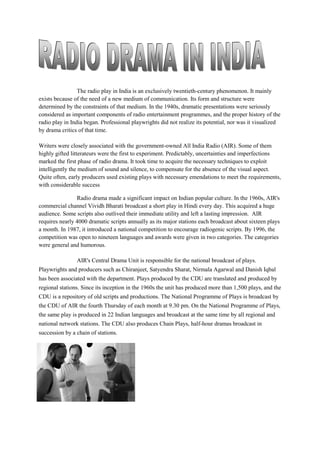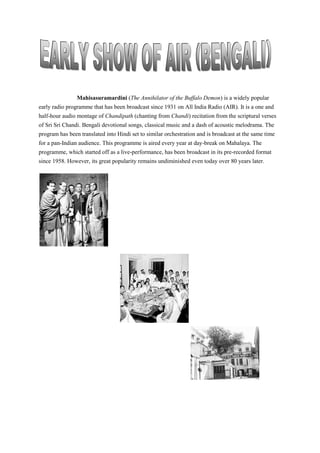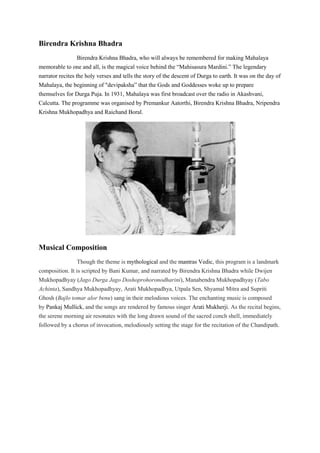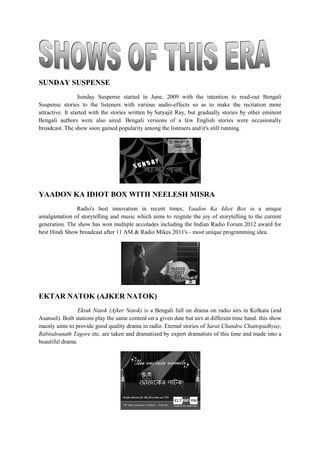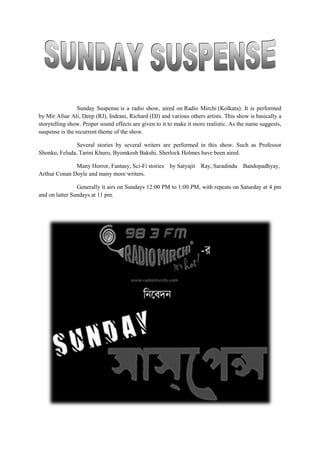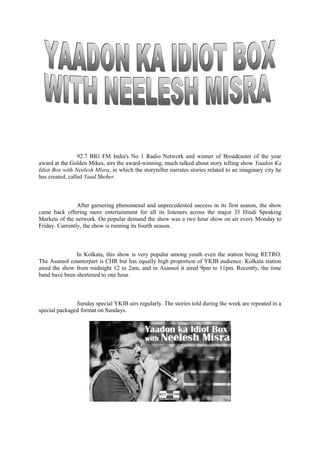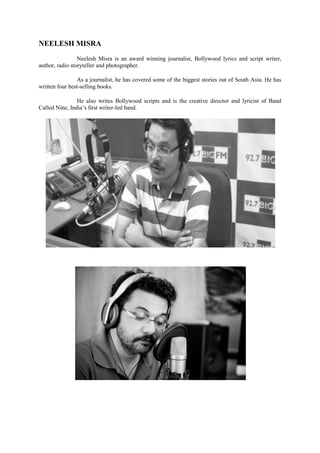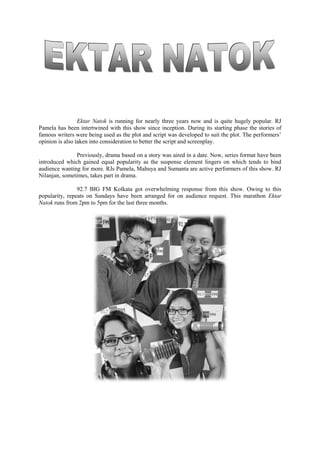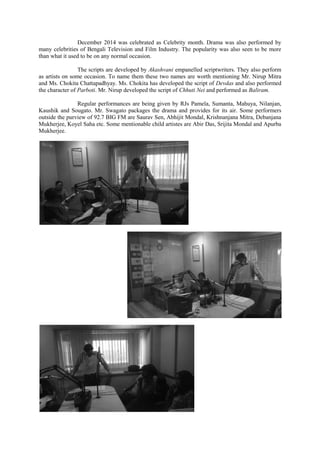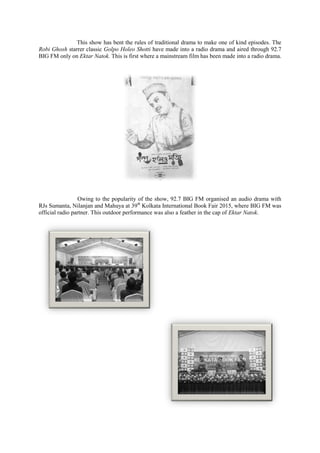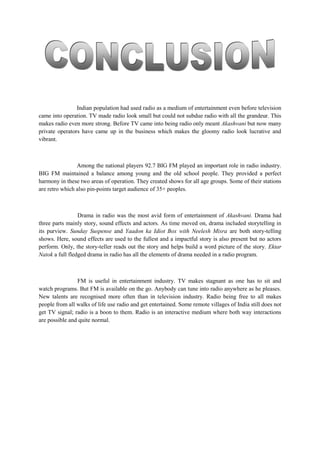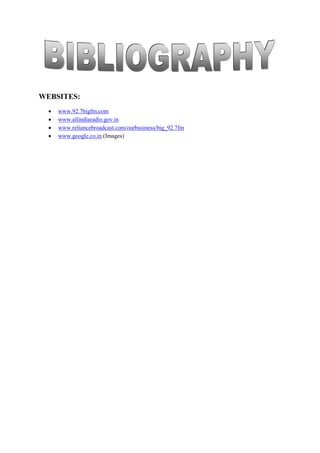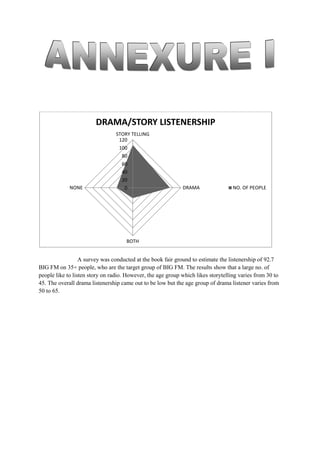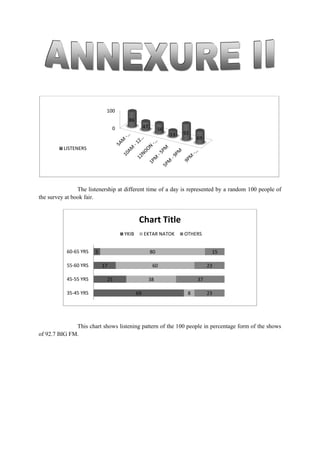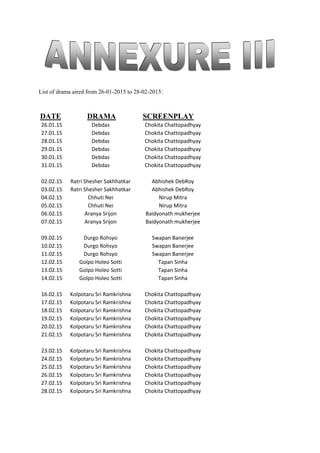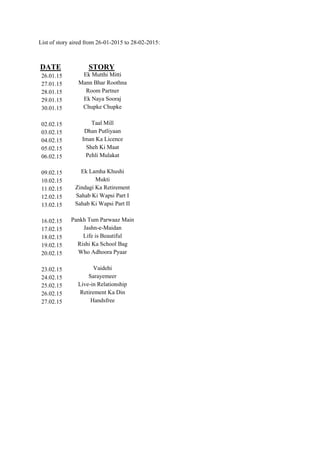TOTAL PROJECT
- 2. ACKNOWLEDGEMENT i FOREWORD ii PREFACE iv COMPANY PROFILE v RADIO IN 21ST CENTURY 1 DRAMA 2 TYPES OF DRAMA 3 EVOLUTION OF DRAMA 4 WILLIAM SHAKESPEARE 6 DRAMA TIMELINE – INDIA 7 DRAMA IN RADIO 8 RADIO DRAMA IN INDIA 9 EARLY SHOWS OF AIR (BENGALI) 10 SHOWS OF THIS ERA 12 SUNDAY SUSPENSE 13 YAADON KA IDIOT BOX WITH NEELESH MISRA 14 EKTAR NATOK 16 CONCLUSION 19 BIBLIOGRAPHY 20 ANNEXURE I 21 ANNEXURE II 22 ANNEXURE III 23
- 3. I am thrilled to have to work on such a good topic of project such as this. This project helped me to overcome my fear and guided me to evolve as a person with the fantastic mentors I had came up front with. I am feeling proud to thank both my institutes for this opportunity viz., Indian Institute of Social Welfare and Management, and Calcutta Media Institute. I am very grateful to my professors to have taught me to implement such knowledge into practical work field. I convey my gratitude to Dr. Sudeepa Banerjee, Mr. Malay Dasgupta, Ms. Debika Mukherjee, Ms. Pamela Mitra et al. I would also like to thank Ms. Barkha Rajpal for allowing me to complete my one month long internship in 92.7 BIG FM starting from 27-01-2015 to 27-02-2015. I also convey my gratitude to all the members of 92.7 BIG FM with whom I have learned many small nitty gritties of work performed there.
- 4. I was allotted to do my one month long internship in 92.7 BIG FM by my institutes where I am studying Post Graduate Diploma in Media Management specialization in Television Management under the guidance of IISWBM and CMI affiliated by University of Calcutta. I started my internship with an Event. I was posted from the first day in 39th Kolkata International Book Fair, 2015 at Milan Mela Ground. I was posted in the production department of the organization. I had to report to RJ Nilanjan at there. During the event I had to perform load many duties than previously mentioned. I tried to do my job to the fullest expectation of the authority. I had to maintain cordial relation with the celebrities who were coming to the makeshift studio for interviews. I, also, had to manage timings of celebrity interviews and was also made to look after the comforts of the celebrities. I was happy doing my job whatever comes my way. I happened to take direct orders from Marketing Head Mr. Ritendra Nath Mitra and perform duties accordingly. I tried to balance all the work so that no work remains unattended. I did some mistakes which I tried not to repeat, which taught me to cope with hard situations keeping a cool head. RJ Nilanjan was the interviewer at Book Fair. I was assigned to help him in any way he might need. I, also, had to co-ordinate with Ms. Mita Sing for broadcasting of the interviews on air. I was also assigned to collect feedback from the celebrities coming for the interview. Ms. Debika Mukherjee, Programming Head and my professor had bestowed upon me a duty to collect feedback from the audiences and visitors. She has helped me to prepare a questionnaire on whose basis the survey is to be conducted. This work was divided among Mr. Tanmoy Patra, my batch-mate and a fellow intern, and me.
- 5. 92.7 BIG FM was the official Radio Partner of Kolkata International Book Fair for the second year. The Kolkata Literary Festival was also partnered by 92.7 BIG FM. The Kolkata Literary Festival was conducted from 6th February to 8th February 2015. This festival has seen many celebrated authors, actors, singers etc. I continued my work as an intern in 92.7 BIG FM after Book Fair was over. I performed my duties as and when anything was bestowed upon me. I had to upload all the incoming shows and check whether it is properly uploaded and the audio running smoothly or not. I uploaded SUHANA SAFAR WITH ANU KAPOOR, SANGEET KE SITARON KI MEHFIL with Ameen Sayani, RAATER OTITHI with RJ Neel and YAADON KA IDIOT BOX WITH NEELESH MISRA. I was supervised by RJ Nilanjan and RJ Mahuya. I, also, compiled the entries for IRF 2015. RJ Sumanta and Mr. Swagato Banerjee had provided all the details and I compiled them and made them available to be sent out. I also assisted RJ Pamela with her outdoor broadcast in Pearless Inn. I also had to collect interview from Swastha Bhawan and Nil Ratan Sarkar Hospital for Rashtriya Swastha Bima Yojana with Ms. Gargi Dey, my batch-mate and a fellow intern. I have tallied all the audio available and compiled the data. The audio list was provided by RJ Nilanjan and I have returned the compiled one. RJ Pamela had helped me in my project as she is in charge of the drama in 92.7 BIG FM Kolkata. Ms. Debika Mukherjee had asked me to research on some current topics which would be required for the upcoming show C/O KOLKATA with Anindya Bose. I have provided information on the said topics on time. She had me tally advertisement per hour for the whole day. I, also, took interview of some celebrities for the promotion of the above mentioned show via telephone. I had to assist Ms. Mita Sing to upload shows for 92.7 BIG FM Asansol during my last week of the internship. I had to upload SWARANAGATO by RJ Sumanta, AAJKER NATOK, and EVENING EXPRESS with RJ Mahuya. I enjoyed my work during the internship period. I have learnt a lot from the persons I came in touch with during my work period. I am really grateful towards each and everyone. Shaswata Mukherjee Student Id: 20140410021 Date 27-02-2015
- 6. Radio Drama is a very popular genre in radio industry. Drama, as the name suggests, has to create an effect on the mind of its recipient which enables them to decipher the intricate message a drama holds in its bosom. Creating dramatic effects is an aesthetic art which has been perfected by radio and spread throughout its reach. Some people like but some don’t prefer to listen drama. Listening to a full drama in its full glory or story-telling, the submissive cousin of drama, helps creating a picture as per individual choice. Drama plays a very crucial role in radio’s popularity. Many youngsters find interest in radio drama because of the adventure it poses in their mind. Matured folks find it relaxing after their hectic schedule at their respective workplace. Older people could connect to their roots and also recollect their childhood memories. BIG FM Kolkata and Asansol has a common daily drama product which airs at different times in the stations. The content for a particular date remains the same. Yadoon Ka Idiot Box with Neelesh Misra is a story-telling show which is extremely popular among radio listeners. Similarly, Sunday Suspense airs in Radio Mirchi is a story telling show which uses dramatic effects.
- 7. Reliance Industries was started by Late Dhirajlal Hirachand Ambani in Bombay. He handed over his business to his sons Mukesh and Anil in 1986 following a stroke which he suffered. Popularly known as Dhirubhai Ambani, he started on his heavenly abode on 6th July 2002, led to separation of the business among his sons. Mukesh got Reliance Industries and Anil took charge over Reliance Anil Dhirubhai Ambani Group. Anil Ambani got the responsibility of Reliance Infocomm, Reliance Energy, Reliance Capital and RNRL. This led to a new beginning called Reliance. He ventured into entertainment industry. 92.7 BIG FM started its journey on 21st Oct 2006 as CHR stations across metros. 92.7 BIG FM was named as such to mark its maturity in the radio technology market. The main tagline of 92.7 BIG FM is Suno Sunao, Life Banao. The Bengali language counterpart is Sono Sonao, Life Jomao. Currently 45 stations are broadcasting throughout India under the frequency 92.7. 92.7 BIG FM started its operations from October 2006 and has never since looked back. It expanded at a phenomenal pace, creating history by launching its 45 station network in record time of 18 months. Through its tagline of Suno Sunao, Life Banao, BIG FM's endeavour is to use the power of radio to not only entertain listeners but also positively influence their lives. This is the only private FM radio station which is being broadcast from Srinagar and Jammu in Jammu & Kashmir state. 92.7 BIG FM has established leadership in the FM space and firmly laid a foundation for an exciting future. With 7 of its stations going retro inclusive of Mumbai, Delhi and Kolkata, 92.7
- 8. BIG FM took the untrodden path and experienced remarkable success with its Hit Thhe, Hit Rahenge (Bengali counterpart Sera Chilo, Sera Thakbe) positioning and is amongst the top radio stations in respective markets. The station also enjoys leadership in cities where the company has brought in the new wave of private FM which has enabled it to be the most sought after radio network across the country. The brand has taken FM as a medium of entertainment beyond the metros, to virgin markets, offering consumers and advertisers a new experience of this medium of entertainment. Its presence spans 45 cities, 1000 towns, and 50,000 villages, and a weekly reach of over four crore Indians across the country. From 2011 to 2014 BIG FM regularly got “Golden Mike Award” for best radio station. After that Big fm is the only radio that got an American award on 2013 which was the Abbys Network. Leaving this they got many other award including “Best Programme”, “Best Community”, “Best Radio Programme” and many other awards also.
- 9. Boasting of impactful programming, the radio network hosts some of the most popular radio shows in the country. Additionally, the radio station also creates locally relevant programmes and capsules to suit the sensibilities of various markets. Suhaana Safar with Annu Kapoor is a resounding success especially in Mumbai and Delhi; the show catapulted the station in these two markets to the No.1 position. Hosted by Annu Kapoor, he takes listeners through an enjoyable ride back in time through “Filmi Duniya Ki Kahi-Ankahi Kahaniyaan”. Yaadon ka Idiot Box with Neelesh Misra is a widely successful radio storytelling format. With an endearing story narrated everyday in the late night slot, Neelesh Misra evokes myriad emotions of the listener in the theatre of his mind.
- 10. Radio is important in the 21st century because it provides an opportunity for people who cannot access television and cannot read to keep up-to-date on the news and trends. According to an American Media Services survey, 78 percent of individuals listen to radio in the car, thus it provides entertainment to many. The radio is important in both developing and fully developed countries for information provision. It is able to function when television stations are not and is more easily accessed than the newspaper is. The information that is given over the radio is able to be broadcast to a large number of listeners and provides them with instantaneous information. The radio is important for already developed countries because it not only provides news information, but it also provides entertainment. Despite the onslaught of digital music, radio stations still play the top hits in various music genres. Radio stations give listeners new music to listen to while also offering a variety of music options. The radio also allows people to keep up-to-date with the latest trends in popular culture.
- 11. Drama is the specific mode of fiction represented in performance. The term comes from a Greek word meaning action, which is derived from the verb meaning to do or to act. The enactment of drama in theatre, performed by actors on a stage before an audience, presupposes collaborative modes of production and a collective form of reception. The two masks associated with drama represent the traditional generic division between comedy and tragedy. They are symbols of the ancient Greek Muses, Thalia and Melpomene. Thalia was the Muse of comedy (the laughing face), while Melpomene was the Muse of tragedy (the weeping face).
- 12. OPERA Western opera is a dramatic art form, which arose during the Renaissance in an attempt to revive the classical Greek drama tradition in which both music and theatre were combined. PANTOMIME These stories follow in the tradition of fables and folk tales. Usually there is a lesson learned, and with some help from the audience, the hero/heroine saves the day. This kind of play uses stock characters seen in masque and again Commedia Dell'arte, these characters include the villain, the clown/servant, the lovers etc. These plays usually have an emphasis on moral dilemmas, and good always triumphs over evil, this kind of play is also very entertaining making it a very effective way of reaching many people. CREATIVE DRAMA Creative drama includes dramatic activities and games used primarily in educational settings with children. Its roots in the United States began in the early 1900s.
- 13. CLASSICAL GREEK DRAMA Western drama originates in classical Greece. The theatrical culture of the city- state of Athens produced three genres of drama: tragedy, comedy, and the satyr play. Their origins remain obscure, though by the 5th century BC they were institutionalised in competitions held as part of festivities celebrating the god Dionysus. CLASSICAL ROMAN DRAMA Following the expansion of the Roman Republic (509–27 BC) into several Greek territories between 270–240 BC, Rome encountered Greek drama. From the later years of the republic and by means of the Roman Empire (27 BC-476 AD), theatre spread west across Europe, around the Mediterranean and reached England; Roman theatre was more varied, extensive and sophisticated than that of any culture before it.
- 14. MEDIEVAL In the Middle Ages, drama in the vernacular languages of Europe may have emerged from religious enactments of the liturgy. Mystery plays were presented on the porch of the cathedrals or by strolling players on feast days. Miracle and mystery plays, along with moralities and interludes, later evolved into more elaborate forms of drama, such as was seen on the Elizabethan stages. ELIZABETHAN AND JACOBEAN One of the great flowerings of drama in England occurred in the 16th and 17th centuries. Many of these plays were written in verse, particularly iambic pentameter. In addition to Shakespeare, such authors as Christopher Marlowe, Thomas Middleton, and Ben Jonson were prominent playwrights during this period. As in the medieval period, historical plays celebrated the lives of past kings, enhancing the image of the Tudor monarchy. Authors of this period drew some of their storylines from Greek mythology and Roman mythology or from the plays of eminent Roman playwrights such as Plautus and Terence. MODERN AND POST-MODERN The pivotal and innovative contributions of the 19th-century Norwegian dramatist Henrik Ibsen and the 20th-century German theatre practitioner Bertolt Brecht dominate modern drama; each inspired a tradition of imitators, which include many of the greatest playwrights of the modern era. The works of both playwrights are, in their different ways, both modernist and realist, incorporating formal experimentation, meta-theatricality, and social critique. In terms of the traditional theoretical discourse of genre, Ibsen's work has been described as the culmination of "liberal tragedy", while Brecht's has been aligned with a historicised comedy.
- 15. William Shakespeare, (26 April 1564 (baptised) – 23 April 1616) was an English poet, playwright, and actor, widely regarded as the greatest writer in the English language and the world's pre-eminent dramatist. He is often called England's national poet and the "Bard of Avon". His extant works, including some collaborations, consist of about 38 plays, 154 sonnets, 2 long narrative poems, and a few other verses, of which the authorship of some is uncertain. His plays have been translated into every major living language and are performed more often than those of any other playwright. CONTRIBUTION TO DRAMA William Shakespeare's plays have the reputation of being among the greatest in the English language and in Western literature. Traditionally, the plays are divided into the genres of tragedy, history, and comedy; they have been translated into every major living language, in addition to being continually performed all around the world.
- 16. SANSKRIT THEATRE The earliest form of Indian drama was the Sanskrit drama that is said to have its framework directly given by Lord Shiva who used these techniques to pray to Lord Vishnu. The earliest-surviving fragments of Sanskrit drama date from the 1st century AD. The ancient Vedas contain no hint of it (although a small number are composed in a form of dialogue) and the rituals of the Vedic period do not appear to have developed into theatre. The Mahābhāṣya by Patañjali contains the earliest reference to what may have been the seeds of Sanskrit drama. This treatise on grammar from 140 BC provides a feasible date for the beginnings of theatre in India. MODERN INDIAN DRAMA Rabindranath Tagore was a pioneering modern playwright who wrote plays noted for their exploration and questioning of nationalism, identity, spiritualism and material greed. His plays are written in Bengali and include Chitra (Chitrangada, 1892), The King of the Dark Chamber (Raja, 1910), The Post Office (Dakghar, 1913), and Red Oleander (Raktakarabi, 1924). Girish Karnad is a noted playwright, who has written a number of plays that use history and mythology, to critique and problematize ideas and ideals that are of contemporary relevance. Karnad's numerous plays such as Tughlaq, Hayavadana, Taledanda and Naga-Mandala are significant contributions to Indian drama. Vijay Tendulkar and Mahesh Dattani are amongst the major Indian playwrights of the 20th century. BENGALI CONTEXT Bengali theatre primarily refers to theatre performed in the Bengali language. Bengali theatre is produced mainly in West Bengal, and in Bangladesh. The term may also refer to some Hindi theatres which are accepted by the Bengali people. Bengali theatre has its origins in British rule. It began as private entertainment in the early 19th century. In the pre-independence period, Bengali theatres played a pivotal role in manifesting dislike of the British Raj. After the independence of India in 1947, leftist movements in West Bengal used theatre as a tool for social awareness. This added some unique characteristics to the art form that still have strong effects. These groups differentiate themselves ideologically from commercial Bengali theatre.
- 17. Radio drama is a dramatized, purely acoustic performance, broadcast on radio or published on audio media, such as tape or CD. With no visual component, radio drama depends on dialogue, music and sound effects to help the listener imagine the characters and story: “It is auditory in the physical dimension but equally powerful as a visual force in the psychological dimension.” Radio drama achieved widespread popularity within a decade of its initial development in the 1920s. By the 1940s, it was a leading international popular entertainment. With the advent of television in the 1950s, however, radio drama lost some of its popularity, and in some countries has never regained large audiences. However, recordings of OTR (old-time radio) survive today in the audio archives of collectors and museums, as well as several online sites such as Internet Archive. 1880–1930: EARLY YEARS Radio drama traces its roots back to the 1880s: “In 1881 French engineer Clement Ader had filed a patent for ‘improvements of Telephone Equipment in Theatres’”. English-language radio drama seems to have started in the United States. A Rural Line on Education, a brief sketch specifically written for radio, aired on Pittsburgh's KDKA in 1921, according to historian Bill Jaker. An important turning point in radio drama came when Schenectady, New York's WGY, after a successful tryout on August 3, 1922, began weekly studio broadcasts of full-length stage plays in September 1922, using music, sound effects and a regular troupe of actors, The WGY Players. 1930–1960s: WIDESPREAD POPULARITY Perhaps America's most famous radio drama broadcast is Orson Welles' The War of the Worlds, a 1938 version of the H. G. Wells novel, which convinced large numbers of listeners that an actual invasion from Mars was taking place.[25] By the late 1930s, radio drama was widely popular in the United States (and also in other parts of the world). There were dozens of programs in many different genres, from mysteries and thrillers, to soap operas and comedies. Among American playwrights, screenwriters and novelists who got their start in radio drama are Rod Serling and Irwin Shaw. 1960–2000: DECLINE IN THE UNITED STATES After the advent of television, radio drama never recovered its popularity in the United States. Most remaining CBS and NBC radio dramas were cancelled in 1960. The last network radio dramas to originate during American radio′s “Golden Age”, Suspense and Yours Truly, Johnny Dollar, ended on September 30, 1962.
- 18. The radio play in India is an exclusively twentieth-century phenomenon. It mainly exists because of the need of a new medium of communication. Its form and structure were determined by the constraints of that medium. In the 1940s, dramatic presentations were seriously considered as important components of radio entertainment programmes, and the proper history of the radio play in India began. Professional playwrights did not realize its potential, nor was it visualized by drama critics of that time. Writers were closely associated with the government-owned All India Radio (AIR). Some of them highly gifted litterateurs were the first to experiment. Predictably, uncertainties and imperfections marked the first phase of radio drama. It took time to acquire the necessary techniques to exploit intelligently the medium of sound and silence, to compensate for the absence of the visual aspect. Quite often, early producers used existing plays with necessary emendations to meet the requirements, with considerable success Radio drama made a significant impact on Indian popular culture. In the 1960s, AIR's commercial channel Vividh Bharati broadcast a short play in Hindi every day. This acquired a huge audience. Some scripts also outlived their immediate utility and left a lasting impression. AIR requires nearly 4000 dramatic scripts annually as its major stations each broadcast about sixteen plays a month. In 1987, it introduced a national competition to encourage radiogenic scripts. By 1996, the competition was open to nineteen languages and awards were given in two categories. The categories were general and humorous. AIR's Central Drama Unit is responsible for the national broadcast of plays. Playwrights and producers such as Chiranjeet, Satyendra Sharat, Nirmala Agarwal and Danish Iqbal has been associated with the department. Plays produced by the CDU are translated and produced by regional stations. Since its inception in the 1960s the unit has produced more than 1,500 plays, and the CDU is a repository of old scripts and productions. The National Programme of Plays is broadcast by the CDU of AIR the fourth Thursday of each month at 9.30 pm. On the National Programme of Plays, the same play is produced in 22 Indian languages and broadcast at the same time by all regional and national network stations. The CDU also produces Chain Plays, half-hour dramas broadcast in succession by a chain of stations.
- 19. Mahisasuramardini (The Annihilator of the Buffalo Demon) is a widely popular early radio programme that has been broadcast since 1931 on All India Radio (AIR). It is a one and half-hour audio montage of Chandipath (chanting from Chandi) recitation from the scriptural verses of Sri Sri Chandi. Bengali devotional songs, classical music and a dash of acoustic melodrama. The program has been translated into Hindi set to similar orchestration and is broadcast at the same time for a pan-Indian audience. This programme is aired every year at day-break on Mahalaya. The programme, which started off as a live-performance, has been broadcast in its pre-recorded format since 1958. However, its great popularity remains undiminished even today over 80 years later.
- 20. Birendra Krishna Bhadra Birendra Krishna Bhadra, who will always be remembered for making Mahalaya memorable to one and all, is the magical voice behind the “Mahisasura Mardini.” The legendary narrator recites the holy verses and tells the story of the descent of Durga to earth. It was on the day of Mahalaya, the beginning of "devipaksha” that the Gods and Goddesses woke up to prepare themselves for Durga Puja. In 1931, Mahalaya was first broadcast over the radio in Akashvani, Calcutta. The programme was organised by Premankur Aatorthi, Birendra Krishna Bhadra, Nripendra Krishna Mukhopadhya and Raichand Boral. Musical Composition Though the theme is mythological and the mantras Vedic, this program is a landmark composition. It is scripted by Bani Kumar, and narrated by Birendra Krishna Bhadra while Dwijen Mukhopadhyay (Jago Durga Jago Doshoprohoronodharini), Manabendra Mukhopadhyay (Tabo Achinta), Sandhya Mukhopadhyay, Arati Mukhopadhya, Utpala Sen, Shyamal Mitra and Supriti Ghosh (Bajlo tomar alor benu) sang in their melodious voices. The enchanting music is composed by Pankaj Mullick, and the songs are rendered by famous singer Arati Mukherji. As the recital begins, the serene morning air resonates with the long drawn sound of the sacred conch shell, immediately followed by a chorus of invocation, melodiously setting the stage for the recitation of the Chandipath.
- 21. SUNDAY SUSPENSE Sunday Suspense started in June, 2009 with the intention to read-out Bengali Suspense stories to the listeners with various audio-effects so as to make the recitation more attractive. It started with the stories written by Satyajit Ray, but gradually stories by other eminent Bengali authors were also aired. Bengali versions of a few English stories were occasionally broadcast. The show soon gained popularity among the listeners and it's still running. YAADON KA IDIOT BOX WITH NEELESH MISRA Radio's best innovation in recent times, Yaadon Ka Idiot Box is a unique amalgamation of storytelling and music which aims to reignite the joy of storytelling to the current generation. The show has won multiple accolades including the Indian Radio Forum 2012 award for best Hindi Show broadcast after 11 AM & Radio Mikes 2011's - most unique programming idea. EKTAR NATOK (AJKER NATOK) Ektak Natok (Ajker Natok) is a Bengali full on drama on radio airs in Kolkata (and Asansol). Both stations play the same content on a given date but airs at different time band. this show mainly aims to provide good quality drama in radio. Eternal stories of Sarat Chandra Chattopadhyay, Rabindranath Tagore etc. are taken and dramatised by expert dramatists of this time and made into a beautiful drama.
- 22. Sunday Suspense is a radio show, aired on Radio Mirchi (Kolkata). It is performed by Mir Afsar Ali, Deep (RJ), Indrani, Richard (DJ) and various others artists. This show is basically a storytelling show. Proper sound effects are given to it to make it more realistic. As the name suggests, suspense is the recurrent theme of the show. Several stories by several writers are performed in this show. Such as Professor Shonku, Feluda, Tarini Khuro, Byomkesh Bakshi, Sherlock Holmes have been aired. Many Horror, Fantasy, Sci-Fi stories by Satyajit Ray, Saradindu Bandopadhyay, Arthur Conan Doyle and many more writers. Generally it airs on Sundays 12:00 PM to 1:00 PM, with repeats on Saturday at 4 pm and on latter Sundays at 11 pm.
- 23. 92.7 BIG FM India's No 1 Radio Network and winner of Broadcaster of the year award at the Golden Mikes, airs the award-winning, much talked about story telling show Yaadon Ka Idiot Box with Neelesh Misra, in which the storyteller narrates stories related to an imaginary city he has created, called Yaad Sheher. After garnering phenomenal and unprecedented success in its first season, the show came back offering more entertainment for all its listeners across the major 35 Hindi Speaking Markets of the network. On popular demand the show was a two hour show on air every Monday to Friday. Currently, the show is running its fourth season. In Kolkata, this show is very popular among youth even the station being RETRO. The Asansol counterpart is CHR but has equally high proportion of YKIB audience. Kolkata station aired the show from midnight 12 to 2am, and in Asansol it aired 9pm to 11pm. Recently, the time band have been shortened to one hour. Sunday special YKIB airs regularly. The stories told during the week are repeated in a special packaged format on Sundays.
- 24. NEELESH MISRA Neelesh Misra is an award winning journalist, Bollywood lyrics and script writer, author, radio storyteller and photographer. As a journalist, he has covered some of the biggest stories out of South Asia. He has written four best-selling books. He also writes Bollywood scripts and is the creative director and lyricist of Band Called Nine, India’s first writer-led band.
- 25. Ektar Natok is running for nearly three years now and is quite hugely popular. RJ Pamela has been intertwined with this show since inception. During its starting phase the stories of famous writers were being used as the plot and script was developed to suit the plot. The performers’ opinion is also taken into consideration to better the script and screenplay. Previously, drama based on a story was aired in a date. Now, series format have been introduced which gained equal popularity as the suspense element lingers on which tends to bind audience wanting for more. RJs Pamela, Mahuya and Sumanta are active performers of this show. RJ Nilanjan, sometimes, takes part in drama. 92.7 BIG FM Kolkata got overwhelming response from this show. Owing to this popularity, repeats on Sundays have been arranged for on audience request. This marathon Ektar Natok runs from 2pm to 5pm for the last three months.
- 26. December 2014 was celebrated as Celebrity month. Drama was also performed by many celebrities of Bengali Television and Film Industry. The popularity was also seen to be more than what it used to be on any normal occasion. The scripts are developed by Akashvani empanelled scriptwriters. They also perform as artists on some occasion. To name them these two names are worth mentioning Mr. Nirup Mitra and Ms. Chokita Chattapadhyay. Ms. Chokita has developed the script of Devdas and also performed the character of Parboti. Mr. Nirup developed the script of Chhuti Nei and performed as Baliram. Regular performances are being given by RJs Pamela, Sumanta, Mahuya, Nilanjan, Kaushik and Sougato. Mr. Swagato packages the drama and provides for its air. Some performers outside the purview of 92.7 BIG FM are Saurav Sen, Abhijit Mondal, Krishnanjana Mitra, Debanjana Mukherjee, Koyel Saha etc. Some mentionable child artistes are Abir Das, Srijita Mondal and Apurba Mukherjee.
- 27. This show has bent the rules of traditional drama to make one of kind episodes. The Robi Ghosh starrer classic Golpo Holeo Shotti have made into a radio drama and aired through 92.7 BIG FM only on Ektar Natok. This is first where a mainstream film has been made into a radio drama. Owing to the popularity of the show, 92.7 BIG FM organised an audio drama with RJs Sumanta, Nilanjan and Mahuya at 39th Kolkata International Book Fair 2015, where BIG FM was official radio partner. This outdoor performance was also a feather in the cap of Ektar Natok.
- 28. Indian population had used radio as a medium of entertainment even before television came into operation. TV made radio look small but could not subdue radio with all the grandeur. This makes radio even more strong. Before TV came into being radio only meant Akashvani but now many private operators have came up in the business which makes the gloomy radio look lucrative and vibrant. Among the national players 92.7 BIG FM played an important role in radio industry. BIG FM maintained a balance among young and the old school people. They provided a perfect harmony in these two areas of operation. They created shows for all age groups. Some of their stations are retro which also pin-points target audience of 35+ peoples. Drama in radio was the most avid form of entertainment of Akashvani. Drama had three parts mainly story, sound effects and actors. As time moved on, drama included storytelling in its purview. Sunday Suspense and Yaadon ka Idiot Box with Neelesh Misra are both story-telling shows. Here, sound effects are used to the fullest and a impactful story is also present but no actors perform. Only, the story-teller reads out the story and helps build a word picture of the story. Ektar Natok a full fledged drama in radio has all the elements of drama needed in a radio program. FM is useful in entertainment industry. TV makes stagnant as one has to sit and watch programs. But FM is available on the go. Anybody can tune into radio anywhere as he pleases. New talents are recognised more often than in television industry. Radio being free to all makes people from all walks of life use radio and get entertained. Some remote villages of India still does not get TV signal; radio is a boon to them. Radio is an interactive medium where both way interactions are possible and quite normal.
- 29. WEBSITES:  www.92.7bigfm.com  www.allindiaradio.gov.in  www.reliancebroadcast.com/ourbusiness/big_92.7fm  www.google.co.in (Images)
- 30. A survey was conducted at the book fair ground to estimate the listenership of 92.7 BIG FM on 35+ people, who are the target group of BIG FM. The results show that a large no. of people like to listen story on radio. However, the age group which likes storytelling varies from 30 to 45. The overall drama listenership came out to be low but the age group of drama listener varies from 50 to 65. 0 20 40 60 80 100 120 STORY TELLING DRAMA BOTH NONE DRAMA/STORY LISTENERSHIP NO. OF PEOPLE
- 31. The listenership at different time of a day is represented by a random 100 people of the survey at book fair. This chart shows listening pattern of the 100 people in percentage form of the shows of 92.7 BIG FM. 0 100 86 47 56 33 92 69 LISTENERS 69 25 17 5 8 38 60 80 23 37 23 15 35-45 YRS 45-55 YRS 55-60 YRS 60-65 YRS Chart Title YKIB EKTAR NATOK OTHERS
- 32. List of drama aired from 26-01-2015 to 28-02-2015: DATE DRAMA SCREENPLAY 26.01.15 Debdas Chokita Chattopadhyay 27.01.15 Debdas Chokita Chattopadhyay 28.01.15 Debdas Chokita Chattopadhyay 29.01.15 Debdas Chokita Chattopadhyay 30.01.15 Debdas Chokita Chattopadhyay 31.01.15 Debdas Chokita Chattopadhyay 02.02.15 Ratri Shesher Sakhhatkar Abhishek DebRoy 03.02.15 Ratri Shesher Sakhhatkar Abhishek DebRoy 04.02.15 Chhuti Nei Nirup Mitra 05.02.15 Chhuti Nei Nirup Mitra 06.02.15 Aranya Srijon Baidyonath mukherjee 07.02.15 Aranya Srijon Baidyonath mukherjee 09.02.15 Durgo Rohsyo Swapan Banerjee 10.02.15 Durgo Rohsyo Swapan Banerjee 11.02.15 Durgo Rohsyo Swapan Banerjee 12.02.15 Golpo Holeo Sotti Tapan Sinha 13.02.15 Golpo Holeo Sotti Tapan Sinha 14.02.15 Golpo Holeo Sotti Tapan Sinha 16.02.15 Kolpotaru Sri Ramkrishna Chokita Chattopadhyay 17.02.15 Kolpotaru Sri Ramkrishna Chokita Chattopadhyay 18.02.15 Kolpotaru Sri Ramkrishna Chokita Chattopadhyay 19.02.15 Kolpotaru Sri Ramkrishna Chokita Chattopadhyay 20.02.15 Kolpotaru Sri Ramkrishna Chokita Chattopadhyay 21.02.15 Kolpotaru Sri Ramkrishna Chokita Chattopadhyay 23.02.15 Kolpotaru Sri Ramkrishna Chokita Chattopadhyay 24.02.15 Kolpotaru Sri Ramkrishna Chokita Chattopadhyay 25.02.15 Kolpotaru Sri Ramkrishna Chokita Chattopadhyay 26.02.15 Kolpotaru Sri Ramkrishna Chokita Chattopadhyay 27.02.15 Kolpotaru Sri Ramkrishna Chokita Chattopadhyay 28.02.15 Kolpotaru Sri Ramkrishna Chokita Chattopadhyay
- 33. List of story aired from 26-01-2015 to 28-02-2015: DATE STORY 26.01.15 Ek Mutthi Mitti 27.01.15 Mann Bhar Roothna 28.01.15 Room Partner 29.01.15 Ek Naya Sooraj 30.01.15 Chupke Chupke 02.02.15 Taal Mill 03.02.15 Dhan Putliyaan 04.02.15 Iman Ka Licence 05.02.15 Sheh Ki Maat 06.02.15 Pehli Mulakat 09.02.15 Ek Lamha Khushi 10.02.15 Mukti 11.02.15 Zindagi Ka Retirement 12.02.15 Sahab Ki Wapsi Part I 13.02.15 Sahab Ki Wapsi Part II 16.02.15 Pankh Tum Parwaaz Main 17.02.15 Jashn-e-Maidan 18.02.15 Life is Beautiful 19.02.15 Rishi Ka School Bag 20.02.15 Who Adhoora Pyaar 23.02.15 Vaidehi 24.02.15 Sarayemeer 25.02.15 Live-in Relationship 26.02.15 Retirement Ka Din 27.02.15 Handsfree

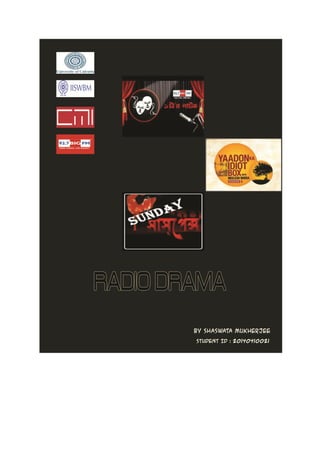
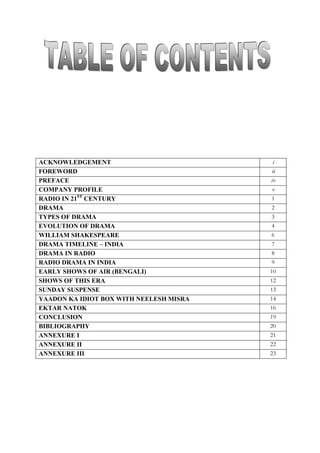
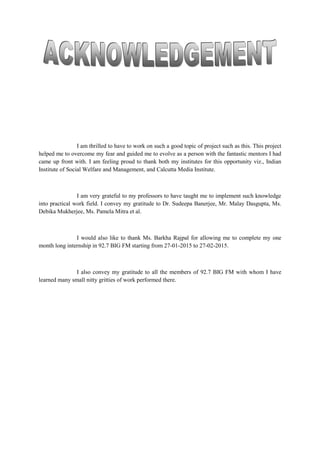
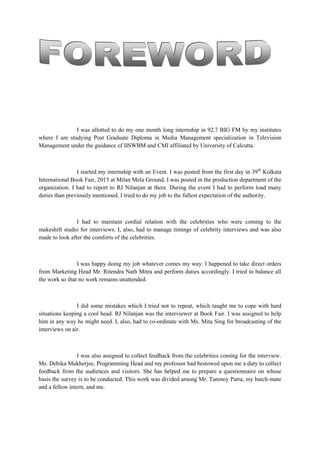
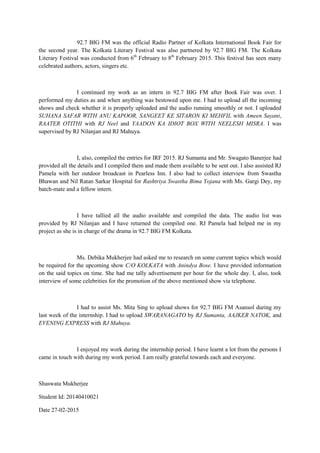
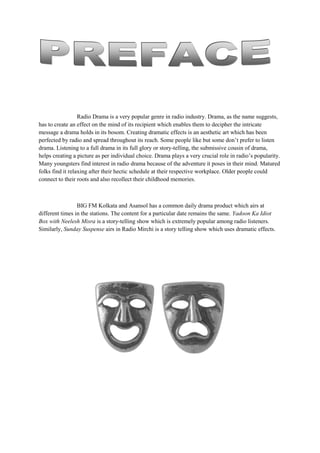

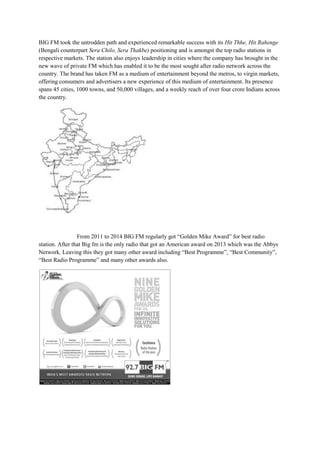
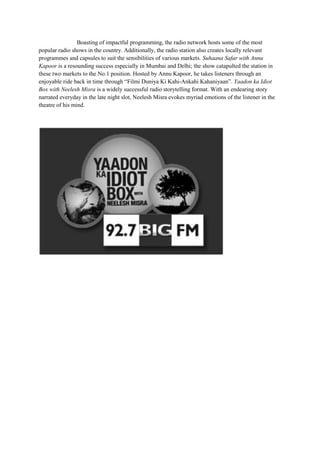
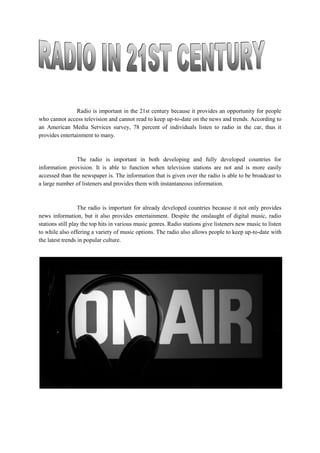
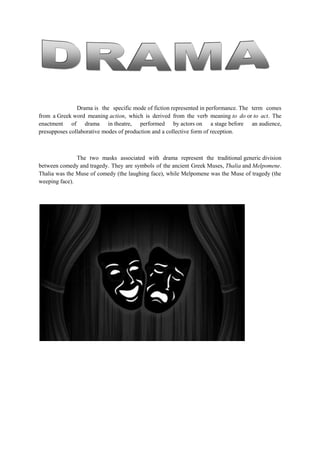
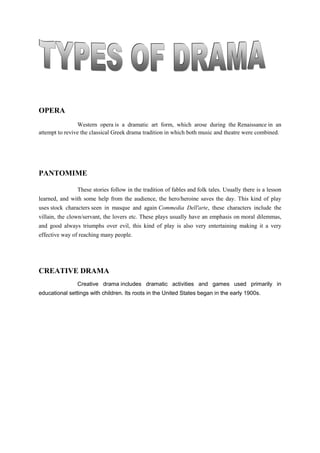
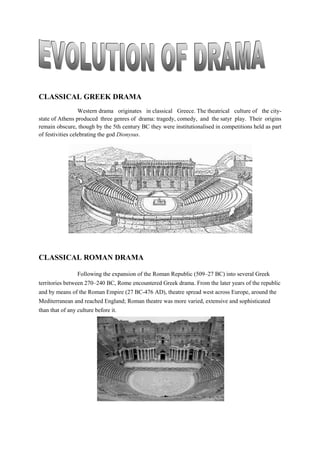
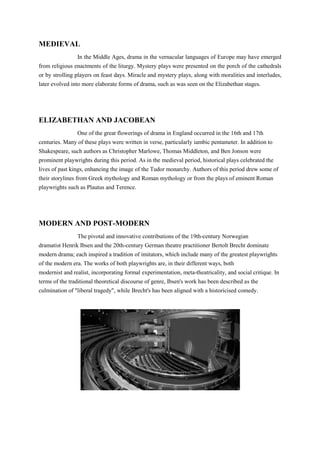
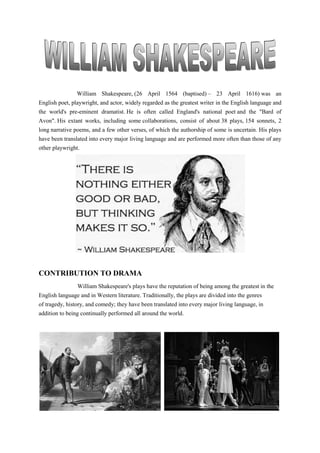
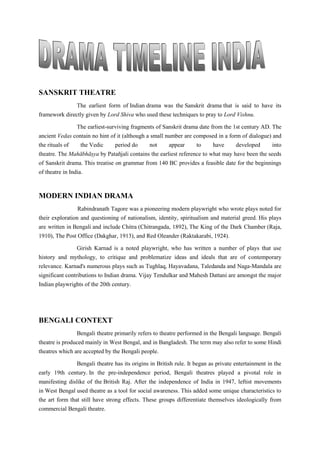
![Radio drama is a dramatized, purely acoustic performance, broadcast on radio or
published on audio media, such as tape or CD. With no visual component, radio drama depends on
dialogue, music and sound effects to help the listener imagine the characters and story: “It is auditory
in the physical dimension but equally powerful as a visual force in the psychological dimension.”
Radio drama achieved widespread popularity within a decade of its initial
development in the 1920s. By the 1940s, it was a leading international popular entertainment. With
the advent of television in the 1950s, however, radio drama lost some of its popularity, and in some
countries has never regained large audiences. However, recordings of OTR (old-time radio) survive
today in the audio archives of collectors and museums, as well as several online sites such as Internet
Archive.
1880–1930: EARLY YEARS
Radio drama traces its roots back to the 1880s: “In 1881 French engineer Clement
Ader had filed a patent for ‘improvements of Telephone Equipment in Theatres’”. English-language
radio drama seems to have started in the United States. A Rural Line on Education, a brief sketch
specifically written for radio, aired on Pittsburgh's KDKA in 1921, according to historian Bill Jaker.
An important turning point in radio drama came when Schenectady, New York's WGY, after a
successful tryout on August 3, 1922, began weekly studio broadcasts of full-length stage plays in
September 1922, using music, sound effects and a regular troupe of actors, The WGY Players.
1930–1960s: WIDESPREAD POPULARITY
Perhaps America's most famous radio drama broadcast is Orson Welles' The War of
the Worlds, a 1938 version of the H. G. Wells novel, which convinced large numbers of listeners that
an actual invasion from Mars was taking place.[25]
By the late 1930s, radio drama was widely popular
in the United States (and also in other parts of the world). There were dozens of programs in many
different genres, from mysteries and thrillers, to soap operas and comedies. Among American
playwrights, screenwriters and novelists who got their start in radio drama are Rod Serling and Irwin
Shaw.
1960–2000: DECLINE IN THE UNITED STATES
After the advent of television, radio drama never recovered its popularity in the
United States. Most remaining CBS and NBC radio dramas were cancelled in 1960. The last network
radio dramas to originate during American radio′s “Golden Age”, Suspense and Yours Truly, Johnny
Dollar, ended on September 30, 1962.](https://image.slidesharecdn.com/cd1fd336-3c1c-4f01-b1dc-28ec50ac51e9-150413020420-conversion-gate01/85/TOTAL-PROJECT-17-320.jpg)
